El Niño in 2014: Still On the Way?
Key Points:
- Development of El Niño in 2014 continues to edge closer with sea surface temperatures (SST) in the key indicator equatorial regions approaching El Niño thresholds.
- Despite the strong initial build-up of a large warm water volume anomaly (WWV) in the equatorial subsurface ocean earlier in the year, the atmosphere has so far not provided sufficient reinforcement to maintain this large pool of warmer-than-average water and a substantial portion has been eroded.
- The last half-century of observations, however, still favour the development of an extreme El Niño event, but the substantial reduction of the warm water volume anomaly (thankfully) diminishes the odds of a powerful event rivaling that of 1997-1998 from taking hold.
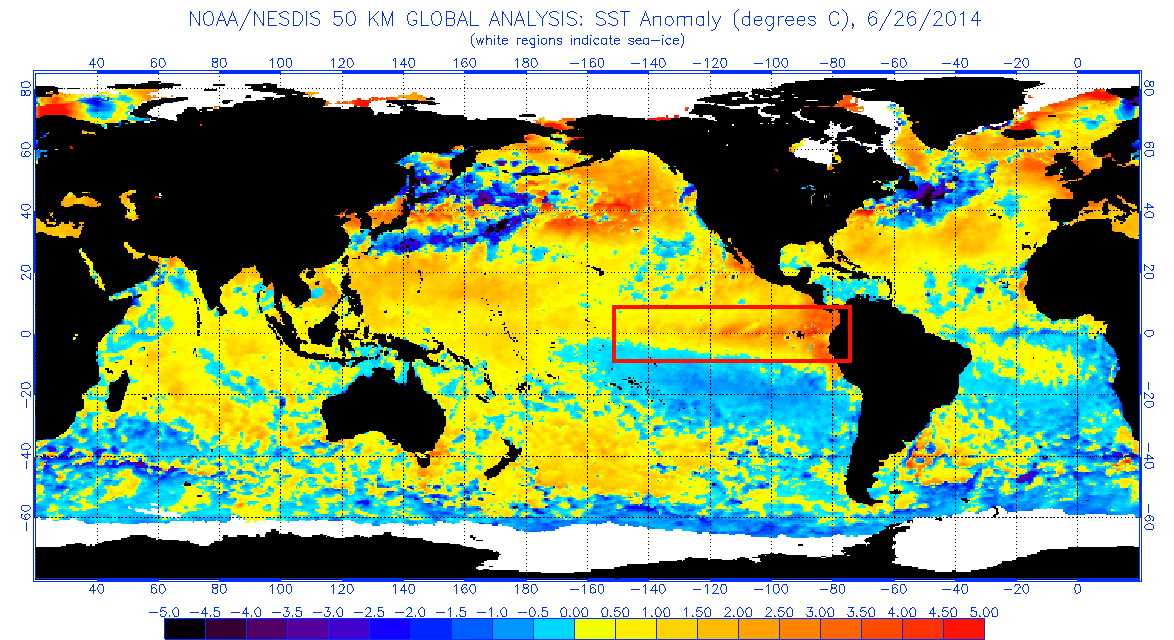
Figure 1 - global sea surface temperature (SST) anomalies (departures from the long-term average) as at 26th June 2014. Strong equatorial SST warming off the coast of South America (shown in red rectangle) is a tell-tale signature of El Nino conditions beginning to form. Image from NOAA Coral Reef Watch.
El Niño on the Wane?.......
The intensity of El Niño is determined by a number of factors but, as discussed in the previous 2014 El Niño post, the size of the equatorial warm water volume (WWV) anomaly is a crucial ingredient because the heat from this warm water volume is discharged to the atmosphere as El Niño matures.
Earlier this year we saw the largest March WWV anomaly ever recorded. This warm anomaly exceeded even that of the monster El Niño of 1997-1998, raising fears of a similarly devastating El Niño in 2014. Fortunately, the chances of a repeat of 1997-1998 appear to have greatly diminished. The atmosphere needs to provide reinforcement in order for El Niño to fully take hold, and although there have been brief episodes of westerly wind bursts, which allow near-surface warm ocean currents to flow back toward the east and shut off the upwelling of cold water there, these have not been of sufficient strength, or persistence, to shut off the upwelling entirely. As a result, the anomalous pool of warm water sitting beneath the eastern Pacific Ocean has been eaten away (moved out of the equatorial region) and is now substantially smaller than before - see Figure 2.
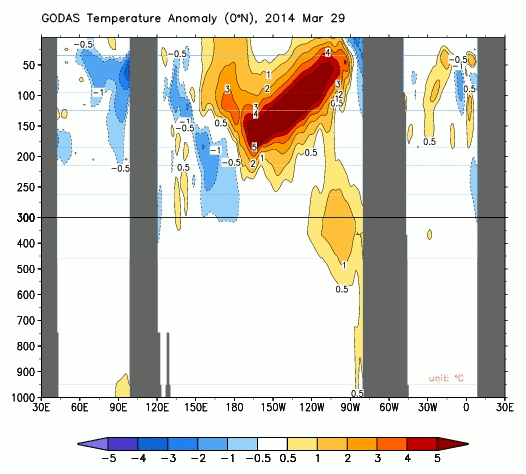
Figure 2 - Global ocean temperature anomaly for the period 29th March-17th June 2014 (the Pacific Ocean is in the centre frame). Note that these are anomalies, not absolute temperatures, so the warmest water is still at the surface. The decline in the equatorial WWV anomaly is obvious as time progresses. Image adapted from CPC GODAS.
One striking aspect of Pacific sea surface temperature patterns in Figure 1 is the difference between the North and South. In the North Pacific, the subtropical gyre - the large rotating mass of surface water in the equatorial to mid latitudes - appears to have spun-down. Consequently, the poleward export of warm surface water northwards out of the tropics has been greatly reduced, and the Pacific Decadal Oscillation (PDO) - an index of sea surface temperatures north of 20° latitude - has switched to a positive (warm) phase in 2014.
This isn't the case for the South Pacific subtropical gyre. The persistent easterly trade winds have the gyre still exporting heat poleward out of the tropics. The two main indicators of this, aside from the ongoing trade winds themselves, are the anomalously warm sea surface temperatures, and anomalous sea surface height, west of New Zealand (the centre of the gyre), and the ongoing upwelling of cold water off the coast of South America.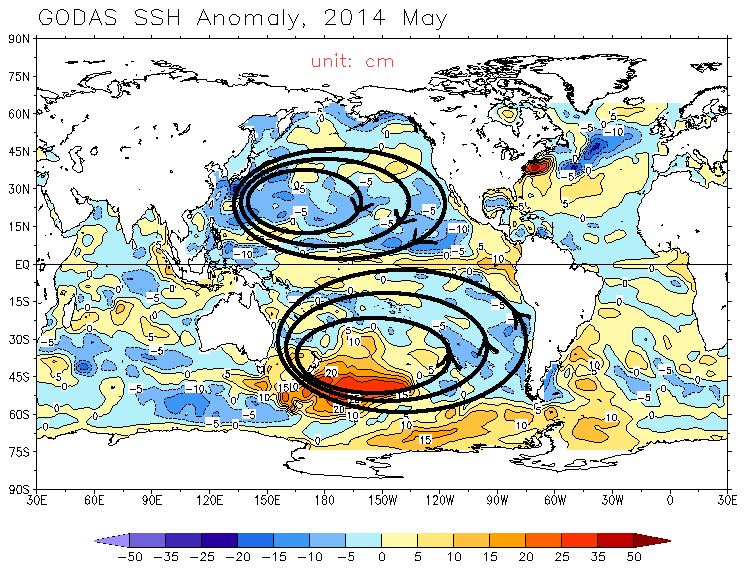
Figure 3 - Global sea surface height (SSH) anomaly for May 2014. The black ellipses are a (very) rough sketch of the Pacific Ocean subtropical gyres, with the arrows denoting the direction of their rotation. Above-average SSH in the South Pacific gyre indicates warm water mass (exported from the tropics) piling up in the centre of the gyre, whereas below average SSH in the North Pacific indicates weaker-than-normal circulation. Units are in centimetres Image adapted from CPC GODAS.
....Or Extreme, Irreversible, El Niño Already Set in Motion?
So, with the subsurface blob of warm water in the eastern equatorial Pacific having decreased substantially, does that mean that there's no risk of an extreme El Niño happening? Well, no, not if the last 50 years of ENSO observations are anything to to go by.
Kim & Cai (2014) looked at the various phases of ENSO since 1960 and found that a strong flow of warm water (Kelvin waves) toward the eastern Pacific during the early, developing, phase of El Niño, specifically the months of April and May, only occurred in the lead-up to events which later matured into extreme El Niño. Kim & Cai (2014) defined an extreme El Niño as those events where sea surface temperatures in the Niño 3 region reached a peak anomaly in excess of 1.2°C above long-term mean. 4 of 16 El Niño in the 50-year observational record fell into the extreme category, namely; 1972-73, 1982-83, 1997-98, and 2009/10.
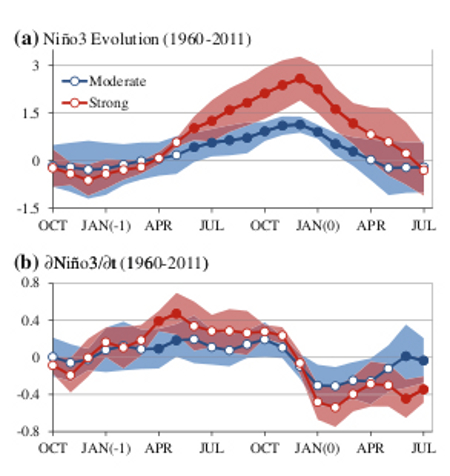
Figure 4 - from Kim & Cai (2014). SST change in the Niño3 region for El Niño years between 1960-2011 with the solid lines indicating the mean. The evolution in Nino 3 SST anomalies for strong & moderate events through the year is shown in (a), and the bottom panel (b) shows the rate of SST change throughout El Niño. The bottom panel demonstrates the importance of the warming rate in the months of April & May in creating the stronger SST warming later in the year. Image from Kim & Cai (2014).
What the authors found is that whenever this strong horizontal transport of warm water from western to eastern Pacific occurs over the critical April-May period, it is inevitably the precursor to an extreme El Niño taking place later in the year (El Niño reaches a peak around December). If this relationship still holds true, then the strong Kelvin wave activity, corresponding anomalous eastward flow of warm water, and the change in sea surface temperatures in the Niño 3 region during April-May this year, portends an extreme El Niño making its presence felt later in 2014.
Reinforcements May be on the Way
Unlike some previous El Nino years, notably the monster 1997-1998 one, the trade winds have picked up strength again over the last 4 weeks, which has held back further El Niño development. This is seen in the Southern Oscillation Index (SOI), which has been positive over the past month - indicating a lower sea level pressure at Darwin than at Tahiti.
For El Niño to keep evolving the atmosphere needs to respond and provide encouragement. This is typically accomplished by convection (evaporation/clouds/rainfall) moving out from the western Pacific to the central Pacific and beyond. Doing so reduces or reverses the sea level pressure gradient between Tahiti and Darwin (and shifts the SOI into negative values), thus shutting down the trade winds temporarily.
Some models predicted that the Madden-Julian Oscillation (MJO), a tropical pulse of cloud and rainfall (i.e. strong convection) that moves eastward along the equator with a cycle of 1-2 months, was due to move eastward out over the equatorial Pacific at the time of writing. If so, we should expect to see westerly wind bursts (WWB) in the western Pacific develop, and early indications are that they have.
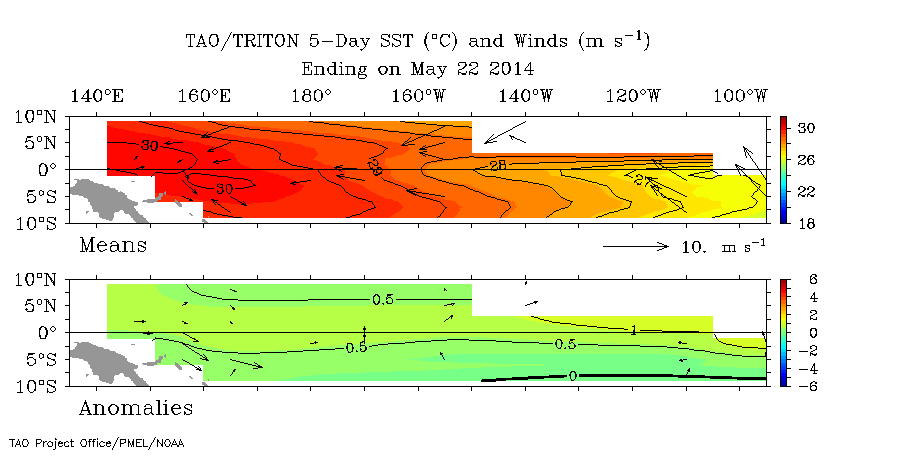
Figure 5 - Tropical SST and wind five-day means (top panel) and anomalies (bottom panel) from 22nd May-26th June 2014. Westerly wind bursts (arrows pointing to the right in bottom panel) die out on May 22, followed by a lull before strengthening again in late June. White areas of the animation are missing data. Note the pool of warmer-than-normal surface water moving westward in the last few frames. Images from the TAO Project.
This means that further Kelvin waves will makes their way across the Pacific Ocean, thus transporting more ocean heat from west to east, and giving the system a further nudge toward El Niño when it reaches the eastern Pacific in about two months time. But for El Niño to take a firm hold, the atmosphere is going to have to play ball by persistently shifting convection out toward the central and eastern Pacific, thereby relaxing the trade winds. Once the trade winds weaken sufficiently, so too will the upwelling of cold water in the east, and the poleward transport of warm surface water out of the tropics.
Let's Not Party Like it's 1997-1998
Earth's weather continues to slowly inch toward El Niño, but the failure of the trade winds to persistently weaken has seen El Niño's development in 2014 delayed. If, as some indicators suggest, the system does develop into a full-blown El Niño we can expect tropical sea surface temperatures to continue to increase right up to the end of the year (see Figure 4) before gradually diminishing in 2015.
Fortunately there has been a marked reduction in the equatorial warm water volume anomaly in the last month, so an El Niño rivaling that of 1997-1998 - the most powerful El Niño of the 20th Century - seems unlikely. But even so, Pacific Ocean trends of the last 50 years demonstrate that the strong equatorial flow of ocean currents toward the eastern Pacific in the critical April-May period, have always preceded extreme El Niño events later the same year. Should this trend continue, and based on observations earlier this year, we could still experience an extreme El Niño in 2014. Only time will tell.
Posted by Rob Painting on Wednesday, 9 July, 2014






